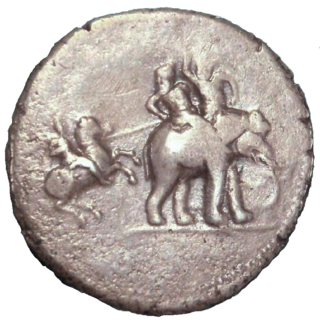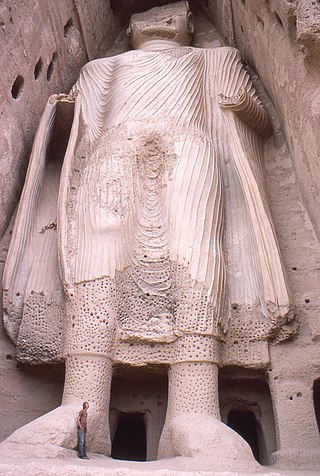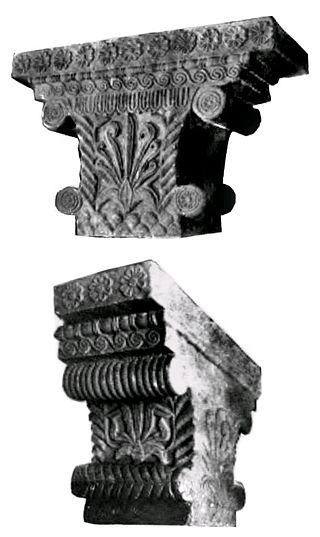
The Seleucid dynasty or the Seleucidae was a Macedonian Greek royal family, which ruled the Seleucid Empire based in West Asia during the Hellenistic period. It was founded by Seleucus I Nicator, a general and successor of Alexander the Great, after the division of the Macedonian Empire as a result of the Wars of the Successors (Diadochi).
The 4th century BCE started the first day of 400 BC and ended the last day of 301 BC. It is considered part of the Classical era, epoch, or historical period.

This article concerns the period 329 BC – 320 BC.

Porus or Poros was an ancient Indian king whose territory spanned the region between the Jhelum River (Hydaspes) and Chenab River (Acesines), in the Punjab region of the Indian subcontinent. He is only mentioned in Greek sources. Credited to have been a legendary warrior with exceptional skills, Porus unsuccessfully fought against Alexander the Great in the Battle of the Hydaspes. In the aftermath, an impressed Alexander not only reinstated him as his satrap but also granted him dominion over lands to the south-east extending as far as the Hyphasis (Beas). Porus reportedly died sometime between 321 and 315 BC.

Seleucus I Nicator was a Macedonian Greek general, officer and successor of Alexander the Great who went on to found the eponymous Seleucid Empire, led by the Seleucid dynasty. Initially a secondary player in the power struggles following Alexander's death, Seleucus rose to become the total ruler of Asia Minor, Syria, Mesopotamia, and the Iranian plateau, assuming the title of basileus (emperor). The Seleucid Empire was one of the major powers of the Hellenistic world, until it was overcome by the Roman Republic and Parthian Empire in the late second and early first centuries BC.

Chandragupta Maurya was the founder of the Maurya Empire, a geographically-extensive empire based in Magadha. He reigned from 320 BCE to 298 BCE. The Magadha kingdom expanded to become an empire that reached its peak under the reign of his grandson, Ashoka the Great, from 268 BCE to 231 BCE. The nature of the political formation that existed in Chandragupta's time is not certain. The Mauryan empire was a loose-knit one with large autonomous regions within its limits.
Afghanistan is a mountainous landlocked country at the crossroads of Central and South (Southern) Asia. Some of the invaders in the history of Afghanistan include the Maurya Empire, the ancient Macedonian Empire of Alexander the Great, the Rashidun Caliphate, the Mongol Empire led by Genghis Khan, the Timurid Empire of Timur, the Mughal Empire, various Persian Empires, the British Empire, the Soviet Union, and most recently the United States with a number of allies in response to the September 11 attacks. A reduced number of NATO troops remained in the country in support of the government under the U.S.–Afghanistan Strategic Partnership Agreement. Just prior to American withdrawal in 2021, the Taliban regained control of the capital Kabul and most of the country. They changed Afghanistan's official name to the Islamic Emirate of Afghanistan.

Greco-Buddhism or Graeco-Buddhism denotes a supposed cultural syncretism between Hellenistic culture and Buddhism developed between the 4th century BC and the 5th century AD in Gandhara, in present-day Pakistan and parts of north-east Afghanistan. While the Greco-Buddhist art shows clear Hellenistic influences, the majority of scholars do not assume a noticeable Greek influence on Gandharan Buddhism beyond the artistic realm.

The Maurya Empire was a geographically extensive Iron Age historical power in South Asia based in Magadha. Founded by Chandragupta Maurya in 322 BCE, it existed in loose-knit fashion until 185 BCE. The empire was centralized by the conquest of the Indo-Gangetic Plain; its capital city was located at Pataliputra. Outside this imperial centre, the empire's geographical extent was dependent on the loyalty of military commanders who controlled the armed cities scattered within it. During Ashoka's rule, the empire briefly controlled the major urban hubs and arteries of the Indian subcontinent excepting the deep south. It declined for about 50 years after Ashoka's rule, and dissolved in 185 BCE with the assassination of Brihadratha by Pushyamitra Shunga and foundation of the Shunga dynasty in Magadha.

The Indo-Greek Kingdom, or Graeco-Indian Kingdom, also known historically as the Yavana Kingdom (Yavanarajya), was a Hellenistic-era Greek kingdom covering various parts of modern-day Afghanistan, Pakistan and northwestern India. This kingdom was in existence from c. 200 BC to c. 10 AD.

The Indo-Scythians were a group of nomadic people of Iranic Scythian origin who migrated from Central Asia southward into the northwestern Indian subcontinent: the present-day South Asian regions of Afghanistan, Pakistan and northern India. The migrations persisted from the middle of the second century BCE to the fourth century CE.
Ancient warfare is war that was conducted from the beginning of recorded history to the end of the ancient period. The difference between prehistoric and ancient warfare is more organization oriented than technology oriented. The development of first city-states, and then empires, allowed warfare to change dramatically. Beginning in Mesopotamia, states produced sufficient agricultural surplus. This allowed full-time ruling elites and military commanders to emerge. While the bulk of military forces were still farmers, the society could portion off each year. Thus, organized armies developed for the first time. These new armies were able to help states grow in size and become increasingly centralized.

The Pauravas were an ancient tribe in the Indus valley, to which King Porus may have belonged.

Paropamisadae or Parapamisadae was a satrapy of the Alexandrian Empire in modern Afghanistan and Pakistan, which largely coincided with the Achaemenid province of Parupraesanna. It consisted of the districts of Sattagydia, Gandhara, and Oddiyana. Paruparaesanna is mentioned in the Akkadian language and Elamite language versions of the Behistun Inscription of Darius the Great, whereas in the Old Persian version it is called Gandāra. The entire satrapy was subsequently ceded by Seleucus I Nicator to Chandragupta Maurya following a treaty.

Buddhism, a religion founded by Gautama Buddha, first arrived in modern-day Afghanistan through the conquests of Ashoka, the third emperor of the Maurya Empire. Among the earliest notable sites of Buddhist influence in the country is a bilingual mountainside inscription in Greek and Aramaic that dates back to 260 BCE and was found on the rocky outcrop of Chil Zena near Kandahar.

Chandragupta is a board wargame designed by Stephen R. Welch and released in 2008 by GMT Games as part of the Great Battles of History (GBoH) series of games on ancient warfare. Chandragupta simulates battles fought by the Mauryan Dynasty in ancient India, and in so doing, attempts to illuminate the features, challenges, and unique attributes of the Indian military system and culture during this period.

The Seleucid–Mauryan War was fought between 305 and 303 BC. It started when Seleucus I Nicator of the Seleucid Empire sought to retake the Indian satrapies of the Macedonian Empire, which had been occupied by Emperor Chandragupta Maurya, of the Maurya Empire.

Chandragupta Maurya is an Indian Historical drama series being broadcast on Dangal TV, based on the life of Chandragupta Maurya, an Indian emperor of ancient India and the founder of the Mauryan Empire. Chandragupta Maurya was first aired in March 2011 on Imagine TV. Ashish Sharma played the adult and Rushiraj Pawar played the young Chandragupta Maurya.

Around 535 BCE, the Persian king Cyrus the Great initiated a protracted campaign to absorb parts of India into his nascent Achaemenid Empire. In this initial incursion, the Persian army annexed a large region to the west of the Indus River, consolidating the early eastern borders of their new realm. With a brief pause after Cyrus' death around 530 BCE, the campaign continued under Darius the Great, who began to re-conquer former provinces and further expand the Achaemenid Empire's political boundaries. Around 518 BCE, the Persian army pushed further into India to initiate a second period of conquest by annexing regions up to the Jhelum River in what is today known as Punjab. At peak, the Persians managed to take control of most of modern-day Pakistan and incorporate it into their territory.

Hellenistic influence on Indian art and architecture reflects the artistic and architectural influence of the Greeks on Indian art following the conquests of Alexander the Great, from the end of the 4th century BCE to the first centuries of the common era. The Greeks in effect maintained a political presence at the doorstep, and sometimes within India, down to the 1st century CE with the Greco-Bactrian Kingdom and the Indo-Greek Kingdoms, with many noticeable influences on the arts of the Maurya Empire especially. Hellenistic influence on Indian art was also felt for several more centuries during the period of Greco-Buddhist art.





















